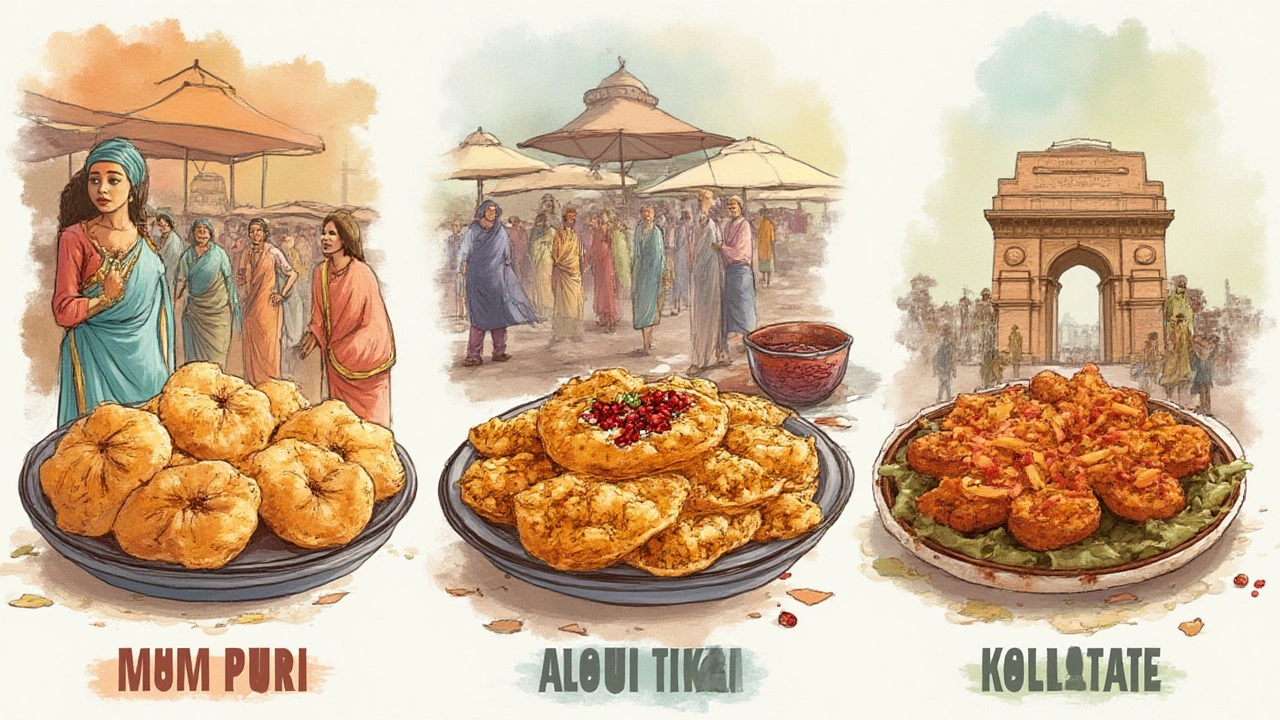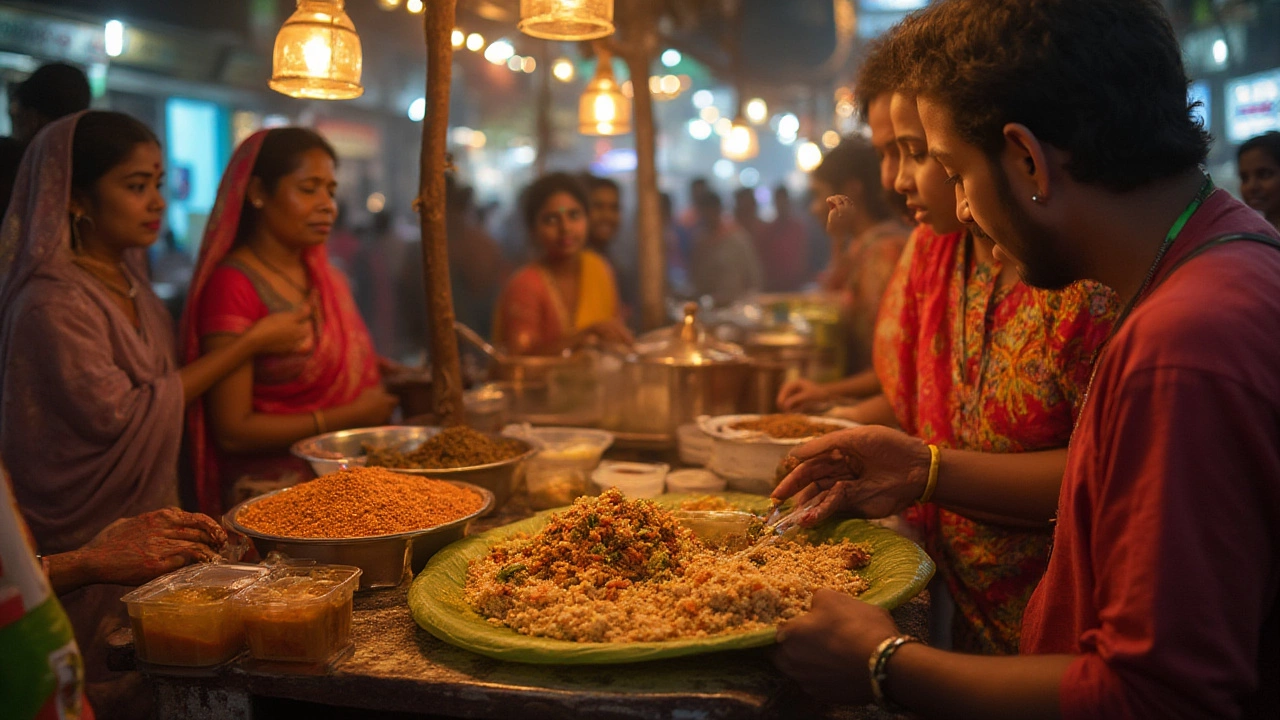Ask ten Indians to name their number one street food—they’ll probably say chaat before you even finish the question. You know you’re in the heart of an Indian city when there’s a crowd jostling around a small cart, hands full of paper plates and the aroma of fried dough, spicy chutneys, and tangy masala dancing in the air. These snack stalls are seriously hard to ignore, not just for their mouthwatering bites but for the cheerful chaos they create on almost every street. I’ve mapped streets in Mumbai, waded into Delhi’s chaat markets, and joined Rohan on wild flavor hunts across Kolkata. No matter where you go—from posh high rises to crowded bazaars—chaat keeps popping up, winning hearts simple as that. But chaat isn’t just a dish. It’s a whole category of snacky, spicy, sweet, and sour creations, each one packed with stories, history, and the right balance of crunch and zing.
The Magic of Chaat: Why It Reigns Supreme
Chaat didn’t just get popular by accident. The word ‘chaat’ comes from the Hindi word meaning “to lick,” and you really do end up licking your fingers clean after a good serving. The magic formula? There’s never just one flavor or texture. Think crispy fried bases—puris, samosas, aloo tikkis—piled with boiled potatoes, chickpeas, cooling yogurt, bright green coriander chutney, spicy tamarind sauce, a shower of onions, and finally, crunchy sev (those thin, fried chickpea noodles). Each bite is chaos and harmony at once—hot and cold, sharp and sweet, squishy and crisp.
What sets chaat apart is adaptability. The same chaat in Lucknow will taste nothing like one in Chennai, because home cooks and street vendors tweak recipes to suit local taste. For example:
- Delhi Aloo Tikki Chaat: Features spiced potato patties, doused in yogurt and mixed chutneys.
- Kolkata Phuchka (Pani Puri): Mini wheat flour puffs stuffed with spicy mashed potatoes, dunked in sour, herby tamarind water.
- Mumbai Bhel Puri: Puffy rice and sev mixed with tomatoes, onions, chilies, chutneys—usually packed in a newspaper cone for extra fun!
- Vada Pav: Spicy mashed potato patty fried and tucked inside a soft bun with garlic chutney. Absolute Mumbai icon.
- Dahi Puri: Puffed balls loaded with yogurt, sweet and spicy chutneys, topped with coriander and crunchy farsan.
Chaat stalls are epicenters of local gossip and family outings. A 2019 survey by “India Food Trends” found that 63% of people in urban areas called chaat their go-to outdoor snack. Even in massive metros like Delhi and Mumbai, thousands of chaat sellers make brisk business every evening, and there are yearly Chaat Festivals, especially in Uttar Pradesh, that draw in thousands of food lovers wanting to crown the best tangy creation.
History and Origins: Where Did Chaat Come From?
Historians think chaat has roots going way back to the 16th century. Some stories trace it to Mughal royal kitchens in Northern India, where cooks added black salt and pepper to local veggies for “digestive” purposes—Delhi’s sticky summers were tough! Over centuries, humble street vendors adopted the kingly snacks, playing around with fried breads and lentils, then layering on new ingredients as cities grew and cultures mixed.
By the mid-1900s, chaat became the unofficial evening meal of India’s working class. Street carts rolled out every evening, loaded with bubbling oil and baskets full of aloo tikkis, chole (chickpeas), and crunchy garnishes. Even after waves of modernization, chaat has stubbornly held on. Many Indians remember childhood evenings at their favorite roadside stall, arguing over who gets the last pani puri and watching their parents chat with the chaatwala about everything from cricket scores to local politics.
Famously, Delhi’s Chandni Chowk, Kolkata’s New Market, and Mumbai’s Chowpatty Beach are now pilgrimage spots for chaat lovers from all over the world. “Golgappa Eating Challenges” have become Instagram trends. In New Zealand, my friends often ask me, “Is chaat just snack food?” I always say: no way, it’s Indian nostalgia in a bowl, spoon, or rolled inside a puri. There’s something magical about the blend of old-world flavors and ever-changing street creativity. The simple pleasure of balancing sour, spice, and crunch is addictive.

Regional Variations: How Every City Puts a Spin on Chaat
If you think all chaats taste the same everywhere, you’re missing the wild fun. Step off the train in Amritsar and you’ll find yourself tempted by chole tikki—thick, spiced chickpeas over fried potato cutlets, drowning in tamarind. Take a walk in Gujarat, and it’s all about Sev Puri: cracker-thin wheat puris with layers of diced potatoes, raw mango, and sweet chutney, crowned with lots of sev.
The South brings in an entirely different vibe. In Hyderabad, try Ragda Pattice—soft patties atop a spicy white pea stew, sprinkled with chopped onions and a hint of lime. And then there’s Bangalore’s Masala Puri: crushed puris soaked in warm, spicy gravy, topped with shredded carrots and coriander. I have a favorite Mumbai trick: add a tiny bit of crushed papad to Bhel Puri for that salty, smoky punch. Life-changing, honestly.
Each city’s personality is splashed through their chaat. Different types of puris, masalas, and chutneys take center stage. Some chaat is sweet and gentle; some, blow-out spicy. Street stalls in Benaras are known for their tamarind-forward chutneys. In Agra, you’ll find “Bedai Chaat”—spicy lentil-stuffed puris with a potato subzi that’ll leave your tongue tingling. Even the presentation changes. In some places, chaat comes on eco-friendly leaf plates; in others, it’s boxed for takeout or wrapped in newspaper. There’s a chaat for every taste, every mood.
| City | Must-Try Chaat | Unique Ingredient |
|---|---|---|
| Delhi | Aloo Tikki Chaat | Amchur (dried mango powder) |
| Mumbai | Bhel Puri | Crushed papad, raw mango |
| Kolkata | Phuchka | Spicy black chickpeas |
| Ahmedabad | Sev Puri | Sev, sweet date chutney |
| Bangalore | Masala Puri | Spicy peas gravy |
Want to try something wild? Mix chaat types at home. Use the bhel base but add pani puri water, or fill dahi puris with spicy chole. Chaat is forgiving—there’s no single “correct” way but a thousand delicious variations.
How to Find and Enjoy Chaat Like a Local
Now that you’re drooling (I definitely am), let’s talk how to get the best chaat—without rookie mistakes. In India, the best chaat isn’t found at fancy spots but at honest-to-goodness roadside carts or the tiniest local shops. The trick? Always follow the crowds. If you see locals lining up, the chaat is almost always next-level. Don’t bother with the posh version unless you’re intimidated by spice or crowds.
Here are a few local secrets for the ultimate chaat experience:
- Go at peak hours. Chaat is freshest when there’s a queue. The ingredients move fast, so you get crispier puris and zingy chutneys.
- Ask for “extra theekha” or “extra meetha.” Most vendors will happily bump up the heat or sweetness to your taste.
- Stand and eat, don’t wait for a table. The best stalls don’t have seating—part of the fun is juggling your paper plate and licking chutney off your fingers.
- Wash it down with a local drink. Try chilled sweet lassi, spicy masala soda, or even a classic Limca if it’s hot out.
- Worried about hygiene? Go to spots with busy turnover and stick to cooked ingredients. Avoid raw salads if your stomach isn’t used to Indian bacteria.
Looking for a beginner’s hack to make chaat at home? It’s easier than it sounds. Most Indian groceries (even in Auckland, where I live) carry ready-to-use sev, papdis (crispy crackers), and chutneys. Grab some, open a can of chickpeas, chop an onion, top with yogurt and store-bought chutneys—done. Don’t fuss about getting it “right.” Chaat’s real joy comes from tasting as you go. If you get hooked, you can start making chutneys from scratch or even frying your own puris. And a final pro-tip: if you ever travel to India, forget the fancy restaurants and hunt down the busiest chaat stall you can find. Trust me; your tastebuds will thank you forever.
